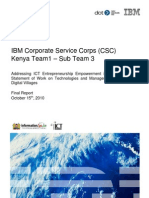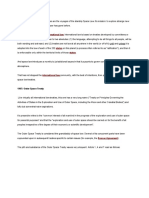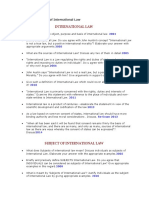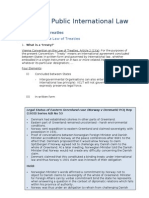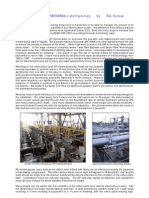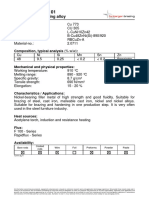Outer Space Law
Outer Space Law
Uploaded by
Raqeeb RahmanCopyright:
Available Formats
Outer Space Law
Outer Space Law
Uploaded by
Raqeeb RahmanOriginal Description:
Copyright
Available Formats
Share this document
Did you find this document useful?
Is this content inappropriate?
Copyright:
Available Formats
Outer Space Law
Outer Space Law
Uploaded by
Raqeeb RahmanCopyright:
Available Formats
Introduction
On October 4, 1957, the Soviet Union launched Earth's first artificial satellite, Sputnik 1. America's second-place finish in the first lap of the Space Race came as a great shock to most Americans, resulting in a complete rethinking of the U.S. space program and American science and technology policy. Few people realize that Sputnik also had far-reaching legal implications. Prior to Sputnik, the legal status of outer space was unclear. The conventional wisdom was that the rules that governed airspace would simply be extended upwards to Earth orbit once humanity began operating in that domain. From as early as 1919, international air law provided that a nation's sovereignty extended vertically to the airspace over its territory. If this rule extended to outer space, the Soviet Union would have violated international law by launching Sputnik into an orbit that passed over many countries, including the United States, without permission. Nevertheless, President Eisenhower, knowing that the United States was interested in eventually overflying Soviet airspace with its own spy satellites, tacitly accepted the Soviet Union's right to operate a satellite in orbit over U.S. territory. It was thus established that the rules that governed spacecraft would differ from those that governed aircraft, and the field of space law was born. The term space law refers to the body of international and national laws and customs that govern human activities in outer space. For the last half century, most outer space operations have been conducted by government agencies. Now, however, we stand at the precipice of a new era in spaceflight. With the retirement of the Space Shuttle, private companies are preparing to assume many of the missions traditionally undertaken by governments and to open outer space to the general public. With these changes, space law will face many new challenges. This article will provide an introduction to space law and some of the issues that the space law community will need to address in the next decade and beyond.
The Outer Space Legal Landscape
The foundational instrument of the outer space legal regime is the 1967 Treaty on Principles Governing the Activities of States in the Exploration and Use of Outer Space, including the Moon and Other Celestial Bodies (the Outer Space Treaty). The Outer Space Treaty established a series of broad principles that have been elaborated upon and implemented in a series of subsequent international treaties and national laws. These principles include: The exploration and use of outer space shall be carried on for the benefit and in the interests of all mankind; Outer space and celestial bodies are free for exploration and use by all States; Outer space and celestial bodies are not subject to national appropriation; No Weapons of Mass Destruction are permitted in outer space; The Moon and other celestial bodies shall be used exclusively for peaceful purposes;
States shall be responsible for their national activities in outer space, whether carried on by governmental or nongovernmental entities; The activities of non-governmental entities in outer space shall require the authorization and continuing supervision by the appropriate State; States shall retain jurisdiction and control over their space objects and any personnel thereon; States shall be liable for damage caused by their space objects; and States shall avoid the harmful contamination of outer space. The Outer Space Treaty was followed by (i) the 1968 Agreement on the Rescue of Astronauts, the Return of Astronauts and the Return of Objects Launched into Outer Space, (ii) the 1972 Convention on International Liability for Damage Caused by Space Objects, (iii) the 1975 Convention on Registration of Objects Launched into Outer Space, and (iv) the 1979 Agreement Governing the Activities of States on the Moon and Other Celestial Bodies, which is now considered dormant because it has not been ratified by any of the major space powers. In addition to the major treaties, the U.N. General Assembly has adopted several resolutions that are generally followed by the international community on a non-binding basis. These include the 1982 Principles Governing the Use by States of Artificial Earth Satellites for International Direct Television Broadcasting, the 1986 Principles Relating to Remote Sensing of the Earth from Outer Space, the 1992 Principles Relevant to the Use of Nuclear Power Sources In Outer Space, and the 1996 Declaration on International Cooperation in the Exploration and Use of Outer Space for the Benefit and in the Interest of All States, Taking into Particular Account the Needs of Developing Countries. The International Telecommunications Union plays an important role in space operations by assigning positions and frequencies for satellites in geostationary orbit, where most telecommunications satellites are located. The U.N. Committee on the Peaceful Uses of Outer Space administers the major space treaties and advises the international community on space policy matters. In the United States, each government agency that operates spacecraft is responsible for complying with U.S. law and international treaty obligations. The Federal Aviation Administration (FAA) regulates non-government spaceports and the launch and reentry of private spacecraft under the Commercial Space Launch Act, as amended by the 2004 Commercial Space Launch Amendments Act. Various other federal laws, such as the 1992 Land Remote Sensing Policy Act and International Traffic in Arms Regulations, state contract and tort laws, and decades of commercial practice in the telecommunications, remote sensing and launch services industries also affect government and private space operations.
The Challenges Ahead
The legal regime established by the Outer Space Treaty has been successful in maintaining peace in outer space since the height of the Cold War. However, there are many issues that current space law is not fully equipped to address. The remainder of this article will discuss four of these issues.
Commercial human spaceflight
Humans will soon routinely travel into outer space on spacecraft built and operated by private companies. The first of these flights will be suborbital spaceflights, where the spacecraft launches from and returns to the same spaceport and is in outer space for only a few minutes. By the middle of the decade, private companies are expected to take passengers on orbital spaceflights to the International Space Station (ISS) and privately operated space habitats. Commercial human spaceflight will raise many complicated legal issues. The FAA is already in the process of establishing licensing and safety criteria for private spacecraft, a process that will continue to evolve as the industry matures. Space companies, legislatures and courts will need to address questions of liability in the event of accidents, the enforceability of liability waivers, insurance requirements, and the sufficiency of informed consent for passengers. Indeed, Florida, New Mexico, Texas, and Virginia have already passed laws limiting the liability of space tourism providers under state tort law.
Space debris
Earth orbit is crowded. As many as 600,000 objects larger than a centimeter (deadly at orbital velocities) are in orbit, and only about 19,000 of those objects can be tracked as of today. Most of these objects are no longer under control and are classified as space debris. Satellites and the ISS are routinely moved to avoid orbital debris, and occasionally the inhabitants of the ISS are required to take shelter in stations lifeboat as a precautionary measure when an avoidance maneuver is not possible. In 2009, two satellites collided in orbit for the first time. If enough debris accumulates, it will become virtually impossible to operate spacecraft in Earth orbit. Current space law does not adequately address the space debris problem. Most importantly, liability for damage caused by space debris is unclear. Under the 1972 Liability Convention, countries are liable for damage caused to other spacecraft only if they act negligently. There is no commonly accepted standard for operating spacecraft in a manner to completely avoid the creation of new space debris, so showing that a spacecraft operator acted negligently could be difficult. It may also be impossible to determine who is ultimately responsible for a debris collision since it is difficult to establish with certainty the origin of most space debris. Moreover, because there is no law of salvage in outer space similar to the law of salvage under maritime law, it is technically illegal for one country to remove another countrys debris without permission.
Export control reform
Currently, all spacecraft, regardless of whether they were built for military or non-military purposes, are classified as defense articles on the United States Munitions List (USML). This classification means that the transfer of space technologies or any information concerning space technologies to any foreign person or country is tightly restricted under the State Departments International Traffic in Arms Regulations (ITAR). These restrictions make it difficult for U.S. space companies to compete in the global space marketplace. In fact, foreign companies sometimes advertise their products as ITAR-free as a selling point to other non-U.S. companies.
A more nuanced approach to controlling the export of space technologies will be required for U.S. space companies to maintain their leadership in this industry. For example, non-military spacecraft, such as communication and research satellites, can be moved off of the USML and onto the less restrictive Commercial Control List maintained by the Commerce Department for dual-use technologies.
Flags of convenience in outer space
Under the Outer Space Treaty, each country retains jurisdiction and control over its governmental and nongovernmental spacecraft. As privately operated spacecraft become more prevalent, countries will need to determine how much regulation is appropriate to impose on their activities. Some countries might seek to attract private space companies by maintaining a loose regulatory regime. This might create a flag of convenience problem where commercial operators register their spacecraft in these countries to reduce operating costs, just as ship operators often register their vessels in flag of convenience countries, such as Panama and Liberia, to take advantage of lower taxes and lax labor and environmental laws. Spacecraft operating under flags of convenience could create safety hazards for their passengers and other spacecraft.
Conclusion
Commercial human spaceflight, space debris, export control reform and flags of convenience are just a few of the challenges that the space law community will face in the coming years. Other issues, such as property rights to outer space resources, will grow in importance as the commercial spaceflight industry matures. Spaceflight lawyers will be at the forefront of helping the space community to meet these challenges and adapt to the new commercial spaceflight paradigm.
You might also like
- DIEDERIKS - VERSCHOOR - An Introduction To Space LawDocument274 pagesDIEDERIKS - VERSCHOOR - An Introduction To Space LawNestor Hidalgo100% (1)
- (Bin Cheng) Studies in International Space LawDocument844 pages(Bin Cheng) Studies in International Space Lawtanmaya_purohit100% (3)
- DUNK - Handbook of Space LawDocument1,136 pagesDUNK - Handbook of Space LawNestor Hidalgo100% (2)
- Air and Space Law BookDocument238 pagesAir and Space Law BookShrawanee KumariNo ratings yet
- Public International Law Exam Notes - Public International Law - International Law PDFDocument51 pagesPublic International Law Exam Notes - Public International Law - International Law PDFStudy GroupNo ratings yet
- Addressing ICT Entrepreneurship Empowerment in Response To Statement of Work On Technologies and Management Tools For Digital VillagesDocument49 pagesAddressing ICT Entrepreneurship Empowerment in Response To Statement of Work On Technologies and Management Tools For Digital VillagesICT AUTHORITY100% (1)
- Application of International Environmental Law in Outer SpaceDocument13 pagesApplication of International Environmental Law in Outer SpaceBharath SimhaReddyNaiduNo ratings yet
- Space LawsDocument5 pagesSpace LawsPooja VikramNo ratings yet
- Assignment - Air and Space LawDocument7 pagesAssignment - Air and Space LawPartha MehrotraNo ratings yet
- Space LawDocument7 pagesSpace LawSherina JunikamNo ratings yet
- International Law: 1967: Outer Space TreatyDocument9 pagesInternational Law: 1967: Outer Space TreatyVishvas DeoNo ratings yet
- International Law and SpaceDocument7 pagesInternational Law and SpaceSanel Sanela BejdicNo ratings yet
- Space Debris Conundrum: Legal Issues Surrounding It'S RemediationDocument8 pagesSpace Debris Conundrum: Legal Issues Surrounding It'S RemediationAnwesa PaulNo ratings yet
- Space Law Treaties and PrinciplesDocument30 pagesSpace Law Treaties and Principlessarayu alluNo ratings yet
- Law of Outer SpaceDocument8 pagesLaw of Outer SpaceKiran KachhawahaNo ratings yet
- Space Law: Dr. Raju KDDocument32 pagesSpace Law: Dr. Raju KDRaju KDNo ratings yet
- Space LawDocument11 pagesSpace Lawdbabygyal1No ratings yet
- Space Law TreatiesDocument4 pagesSpace Law TreatiesraitrisnaNo ratings yet
- Domestic Air Laws in IndiaDocument20 pagesDomestic Air Laws in Indiaakshay royalNo ratings yet
- Air and Space Law6482Document33 pagesAir and Space Law6482mansavi bihaniNo ratings yet
- Space Law Seminar BharatDocument26 pagesSpace Law Seminar BharatBharat JoshiNo ratings yet
- Air and SpaceDocument45 pagesAir and SpaceupendraNo ratings yet
- Outer Space Debris: An International Obligation To Mitigate & ControlDocument17 pagesOuter Space Debris: An International Obligation To Mitigate & ControlarnavNo ratings yet
- Air LawDocument14 pagesAir LawSand M CNo ratings yet
- International Law - Exam NotesDocument66 pagesInternational Law - Exam NotesEleanor100% (1)
- Outer Space TreatyDocument10 pagesOuter Space TreatyChaddhaNo ratings yet
- Environmental Protection in Outer SpaceDocument13 pagesEnvironmental Protection in Outer SpaceHarman SainiNo ratings yet
- Seminar Paper of Air and Space LawDocument21 pagesSeminar Paper of Air and Space LawAnkana MukherjeeNo ratings yet
- Meaning of The State ResponsibilityDocument25 pagesMeaning of The State ResponsibilityKAYNATALINo ratings yet
- Repeated Questions of International LawDocument10 pagesRepeated Questions of International LawAdeel ArifNo ratings yet
- The Law of ArrestsDocument29 pagesThe Law of ArrestsimranNo ratings yet
- Air and Space LawDocument5 pagesAir and Space Lawvaibhav kumarNo ratings yet
- Legal Framework AssignmentDocument4 pagesLegal Framework AssignmentGiridharan Arsenal0% (1)
- Advanced Public International Law - Study NotesDocument136 pagesAdvanced Public International Law - Study NotesBee Wynne75% (4)
- Space LawDocument88 pagesSpace LawSankar SubrahmaniyamNo ratings yet
- Martian Law: U.N. Says World's Population Will Reach 9.8 Billion by 2050. 8-Billion-By-2050Document9 pagesMartian Law: U.N. Says World's Population Will Reach 9.8 Billion by 2050. 8-Billion-By-2050Arif ZamaniNo ratings yet
- Indian Carriage LawDocument38 pagesIndian Carriage LawSharath Kanzal100% (1)
- Air and Space LawDocument6 pagesAir and Space LawANJALI RAJ100% (1)
- GIs in India, Contemporary Challenges and SolutionsDocument226 pagesGIs in India, Contemporary Challenges and SolutionsAmlan Chakraborty100% (1)
- Aerial Hijacking and The International LawDocument14 pagesAerial Hijacking and The International LawAnonymous vUVxDQNo ratings yet
- Memorial For ApplicantsDocument26 pagesMemorial For ApplicantsVarsha ThampiNo ratings yet
- Assignment On International LawDocument6 pagesAssignment On International LawUmer AminNo ratings yet
- Law of International OrganisationDocument3 pagesLaw of International Organisationmahatheer mohamedNo ratings yet
- State SuccessionDocument25 pagesState Successionsanjana sethNo ratings yet
- AirLaws History ConventionsDocument45 pagesAirLaws History ConventionsYenoh SisoNo ratings yet
- Elon Musk Announces His Plan To Colonise Mars and Save Humanity.Document2 pagesElon Musk Announces His Plan To Colonise Mars and Save Humanity.Ritwik PrakashNo ratings yet
- Central University of South Bihar: Academic YearDocument10 pagesCentral University of South Bihar: Academic YearPrateek SinghanNo ratings yet
- Public International LawDocument71 pagesPublic International LawPUNJAB CONWARENo ratings yet
- Intervention in International LawDocument4 pagesIntervention in International LawTribhuwan JoshiNo ratings yet
- Air Carriers Liability in Cases of DelayDocument17 pagesAir Carriers Liability in Cases of Delayadityaprakoso100% (1)
- Air & Space Law FDDocument23 pagesAir & Space Law FDShourya GargNo ratings yet
- State Succession - PPT PDFDocument21 pagesState Succession - PPT PDFAbhinav KumarNo ratings yet
- International Law NotesDocument84 pagesInternational Law Notesuokoroha100% (1)
- Memorial - Team - 23A - Applicant's MemorialDocument59 pagesMemorial - Team - 23A - Applicant's MemorialAshutosh KrNo ratings yet
- Air and Space LawDocument15 pagesAir and Space LawApoorva YadavNo ratings yet
- University Institute of Legal StudiesDocument15 pagesUniversity Institute of Legal StudiesNimrat kaurNo ratings yet
- SemIV PragyaJain SecC RollNo 101 PublicInternationalLawDocument30 pagesSemIV PragyaJain SecC RollNo 101 PublicInternationalLawdurgesh kumar gandharveNo ratings yet
- Air and Space Law PaperDocument25 pagesAir and Space Law PaperK.MeghanaNo ratings yet
- Law of SeaDocument268 pagesLaw of SeaAnonymous tOgAKZ8No ratings yet
- The First-Ever Artificial Satellite, Sputnik 1, Took To The Skies On Oct. 4, 1957 As Launched by The Soviet Union.Document4 pagesThe First-Ever Artificial Satellite, Sputnik 1, Took To The Skies On Oct. 4, 1957 As Launched by The Soviet Union.Rustom IbanezNo ratings yet
- IlluminationDocument130 pagesIlluminationsavvymovNo ratings yet
- Cipelt Application Form Portugal Paulo TavaresDocument2 pagesCipelt Application Form Portugal Paulo TavaresPaulo Tavares100% (1)
- Armalite Arms 2012 CatalogDocument40 pagesArmalite Arms 2012 Catalogsergey62No ratings yet
- Lecture 1 Handout Introduction Object Oriented Programming1Document13 pagesLecture 1 Handout Introduction Object Oriented Programming1Sutan Daffa Satria HertantoNo ratings yet
- Operator Screen (HMI) Design Guidelines: One Clever Solution After AnotherDocument14 pagesOperator Screen (HMI) Design Guidelines: One Clever Solution After AnotherJJBAnonymousNo ratings yet
- Barney Popsicle AssignmentDocument7 pagesBarney Popsicle AssignmentmissbellsstudentsNo ratings yet
- SodapdfDocument1 pageSodapdffadmayantifaisalNo ratings yet
- Nabh Mis PaDocument11 pagesNabh Mis PaAnkurNo ratings yet
- Ground Floor Dining Hall Opening PlanDocument1 pageGround Floor Dining Hall Opening PlanJomo-Rhys GilmanNo ratings yet
- NRV - IntervalveDocument2 pagesNRV - IntervalveRajkishorNo ratings yet
- List of Lenovo MFG Sites and SuppliersDocument58 pagesList of Lenovo MFG Sites and Suppliersrazvanandrey2007No ratings yet
- Masoneilan Noise Control PDFDocument24 pagesMasoneilan Noise Control PDFwindoutNo ratings yet
- Flow Measurement in RefineriesDocument2 pagesFlow Measurement in Refinerieslgarcia9626No ratings yet
- Pandavapura-Sri Lakshmi Venkateshwara Fuels PesoDocument1 pagePandavapura-Sri Lakshmi Venkateshwara Fuels PesoDileep K MahadevaiahNo ratings yet
- Swt551 Object Oriented Analysis and Design Patterns TH 1.00 Ac23Document1 pageSwt551 Object Oriented Analysis and Design Patterns TH 1.00 Ac23netgalaxy2010No ratings yet
- Improvised Car Bumper With Carbon Fiber Reinforced PlasticDocument12 pagesImprovised Car Bumper With Carbon Fiber Reinforced PlasticSITI AMINAH BINTI GHAZALINo ratings yet
- Route CardDocument1 pageRoute CardMario DawsonNo ratings yet
- Fontargen A 101Document1 pageFontargen A 101Kara WhiteNo ratings yet
- Determine-The-Optimal-Span-Between-Pipe Supports-For-Thin-Walled-Piping-Systems PDFDocument10 pagesDetermine-The-Optimal-Span-Between-Pipe Supports-For-Thin-Walled-Piping-Systems PDFLuis Pereira PeñaNo ratings yet
- Automation TestingDocument35 pagesAutomation TestingAnuj Batta50% (2)
- Pryda's Specifi Cation Guide For Floor and Rafter Truss SystemsDocument48 pagesPryda's Specifi Cation Guide For Floor and Rafter Truss SystemsStructural EngineerNo ratings yet
- Financial Assistance For Final Year UG Students 21 1Document8 pagesFinancial Assistance For Final Year UG Students 21 1Rãkêsh GõwdâNo ratings yet
- Belt and Chain Drives ELMESDocument9 pagesBelt and Chain Drives ELMESRif'an am'ulyaNo ratings yet
- Computer Aided Jacquard DesigningDocument89 pagesComputer Aided Jacquard Designingusmante80% (5)
- EINNDocument17 pagesEINNA340_600No ratings yet
- Server: Quiz 2 Form 5 Answer All QuestionsDocument2 pagesServer: Quiz 2 Form 5 Answer All QuestionsAfyudin AlanNo ratings yet
- UAE Qualifications FrameworkDocument8 pagesUAE Qualifications FrameworkTonyP1958No ratings yet
- An Irish GeniusDocument4 pagesAn Irish GeniuslotsauploadzNo ratings yet
- 03a-306a3 - Pilling Machine ChecklistDocument2 pages03a-306a3 - Pilling Machine ChecklisttanoycometNo ratings yet





